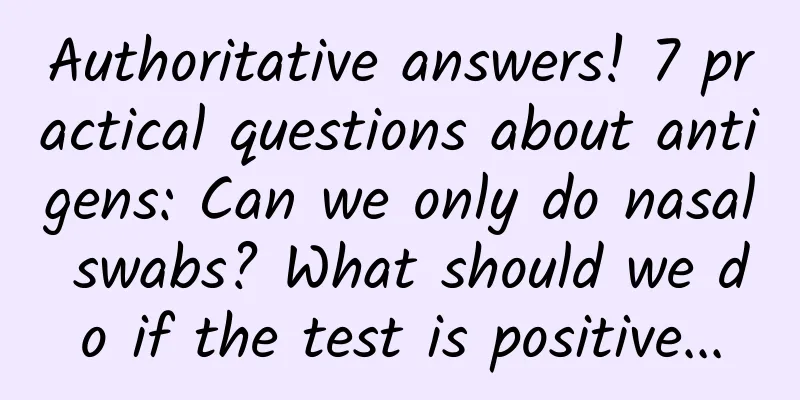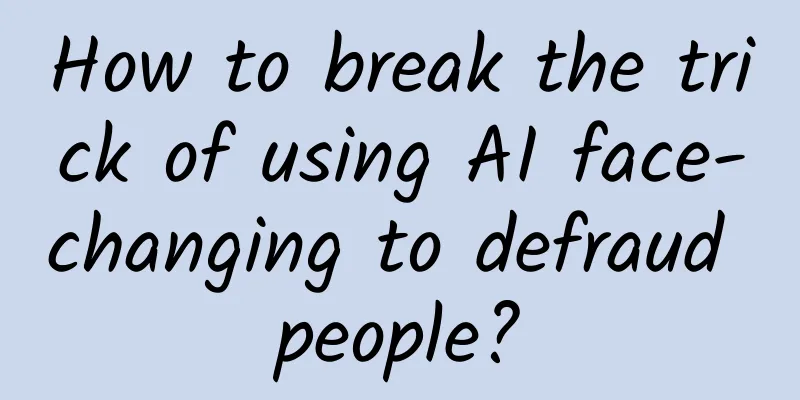Authoritative answers! 7 practical questions about antigens: Can we only do nasal swabs? What should we do if the test is positive...

|
Yesterday, the Comprehensive Group of the Joint Prevention and Control Mechanism of the State Council issued the "Notice on Further Optimizing and Implementing COVID-19 Prevention and Control Measures", which clearly stated that "the scope of nucleic acid testing will be further narrowed and the frequency will be reduced. Antigen testing can be carried out according to the needs of epidemic prevention work." Regarding antigen testing, Science Popularization China previously introduced the principles, methods and precautions of antigen testing in the article "Will eating oranges turn you "positive"? Is antigen testing accurate?" Today, we have invited experts from the Public Health Physicians Branch of the Chinese Medical Doctor Association to authoritatively interpret the seven practical issues that everyone is most concerned about: ● How to buy antigen test kit? What should I pay attention to when purchasing? ● Can I go to the hospital for treatment based solely on the antigen result? ● When is antigen testing needed and how should the test results be used? ● Is it necessary to take a nasal swab for antigen testing? ● The whole family needs to undergo antigen testing. What should we pay attention to? ● How to help disabled family members and infants with antigen testing? ● If the test result is positive, how to avoid infecting others? 01 How to buy antigen test kit? What should I pay attention to when purchasing? Antigen test kits are now available for purchase at offline retail pharmacies and online platforms. When purchasing offline, customers should try to choose regular retail pharmacies, and when purchasing online, they should try to choose professional and reputable shopping websites and platforms. When purchasing and after purchasing the product, check the packaging, label, production date, expiration date and other Chinese labels and medical device product registration certificate number and other information: (1) Check the production date and expiration date . The shelf life of the testing reagents varies depending on their quality stability. The shelf life of different approved products ranges from 3 months, 6 months, 12 months to 18 months. (2) Check whether there is a medical device registration certificate number and complete UDI code (Unique Device Identifier) approved by the National Medical Products Administration . (3) Check whether the product composition is complete , including: reagent plate (the minimum usage unit must have a digital code), lysis solution, disposable sampling swab, instruction manual, and sealed bag. (4) To avoid missing variant strains, reagents with the intended purpose of detecting N and S dual antigens and a detection threshold of less than 80 TCID50 can be used if conditions permit. The sensitivity and specificity values of the reagents are marked in the instructions of the kit, and it is recommended to use reagents with a sensitivity and specificity greater than 92%. Copyright image, no permission to reprint The relevant national market supervision departments will gradually increase the quality supervision of antigen detection products. Consumers can check the authenticity of the registration certificate number on the official website of the National Medical Products Administration. If you find that the purchased coronavirus antigen testing reagents have quality problems or are produced and sold without permission, you can call the reporting hotline 12315 to file a complaint. 02 What are the current applications of antigen test results? Can I go to the hospital for treatment based solely on the antigen result? As a supplementary method, antigen testing has been widely used in screening of specific populations : 1) People who visit primary medical and health institutions with respiratory and fever symptoms and whose symptoms appeared within 5 days. 2) Persons under quarantine and observation, including those under home quarantine and observation, close contacts and secondary close contacts, those under entry quarantine and observation, and those in sealed-off areas and controlled areas. 3) Community residents who have the need for antigen self-testing. According to the plan of the Comprehensive Group of the Joint Prevention and Control Mechanism of the State Council for Responding to the Novel Coronavirus Pneumonia Epidemic to further optimize and implement epidemic prevention and control measures, important government agencies, large enterprises, pre-examination and triage offices of medical institutions and some specific places can allow entry and exit based on the results of on-site or advance antigen testing according to local requirements. In the absence of nucleic acid results, some medical institutions allow patients to go to the hospital emergency department or outpatient clinic based on the antigen results, but they still need to take additional nucleic acid tests during the treatment. 03 When is antigen testing needed? How to use the test results? Antigen testing is generally used during the acute infection period, that is, sample testing within 7 days of the onset of symptoms in suspected people . If you find flu symptoms, such as fever, dry cough, muscle aches, etc., you can conduct self-testing screening. Positive results can be used for early triage and rapid management of suspected people, but cannot be used as a basis for confirming new coronavirus infection. Beijing, Shanghai, Guangdong, Zhejiang, Hebei and other places can test themselves in advance and report on the platform, and upload the test results . At present, according to the different local platform systems, the results can be uploaded manually, or the results can be uploaded by scanning the "unique identification QR code" on the antigen reagent plate on the management platform of the area where the code is located and taking a photo. Whether it is bound to the health code and other platforms, and the validity period of the certification time, etc. depends on the local epidemic prevention policy . For antigen tests conducted on-site, you will need to wait 15 minutes for the results. It should be noted that the results displayed after 20 minutes of testing are invalid . Antigen test is generally positive within 7 days after infection, and nucleic acid test is generally positive within 14 days after infection. Copyright image, no permission to reprint 04 Why is it necessary to take a nasal swab for antigen testing? How to control the depth and number of circles? Generally speaking, antigen testing using a nasal swab is usually more accurate. Antigen testing can be done by extracting secretions from the nasopharynx or oropharynx. Usually, the nasopharynx has more secretions than the oropharynx. If the body is infected with a virus, the virus content in the nasopharynx will be significantly higher than that in the oropharynx, so extracting secretions from the nasopharynx for testing will make the test results more accurate. Those aged 14 and above can take nasal swab samples on their own. Before taking samples, the self-examiner should wipe off the nasal mucus with a tissue, hold the tail of the nasal swab with his hand, slightly tilt his head back, and insert the nasal swab into one nostril. After slowly inserting 1-1.5 cm along the nasal passage, rotate the swab against the nasal cavity for at least four circles, stay for more than 15 seconds, and then repeat the above operation in the other nasal cavity using the same swab. Self-testers aged 2-14 years old should be tested by other adults. Insert the swab 1 cm deep into the inferior nasal cavity and rotate it at least 4 times, staying for at least 15 seconds. Repeat the same action on the other nasal cavity with the same swab. In addition, when taking the swab, be careful not to contaminate the swab head, otherwise it may affect the result and cause a false positive or false negative. 05 The whole family needs to take antigen test What should I pay attention to? The following requirements should be noted: (1) Disinfection. Everyone needs to wash their hands with running water or hand disinfectant before and after operation. (2) Understand the testing process. Carefully read the instructions for the antigen self-test kit and the precautions for antigen self-testing. (3) Reagent preparation. Check whether the antigen self-test reagent is within the shelf life, and check whether the contents of the nasal swab, sampling tube, test card, etc. are missing or damaged. If the reagent is expired or the reagent contents are missing or damaged, the test reagent should be replaced in time. (4) Confirm the test requirements for ambient temperature and humidity. Colloidal gold test strips are generally tested at room temperature of 14°C-30°C to avoid abnormal test results caused by excessively cold, hot or humid environments. After removing the packaging, place the antigen test card in a flat, clean place. (5) When helping self-examiners aged 2-14 to take samples, avoid touching the swab head with your hands and disinfect it promptly. (6) If the test result is negative, all used nasal swabs, sampling tubes, test cards, etc. shall be placed in a sealed bag and disposed of as general waste. If the test result is positive, they shall be handed over to the medical institution and disposed of as medical waste when the person is transferred. (7) Report test results promptly. 06 How to help disabled family members and infants with antigen testing? (1) Disabled family members: First, it is a question of timing for testing. It is not recommended to test disabled family members unless necessary. If there are indeed symptoms of infection, it is recommended to test at home. When helping them to test, it should be noted that there should be two people at home to help the disabled patient to sit up, and then one person should make sure to fix his head while the other collects the nasal swab. During the process, it should be ensured that the collection stick is parallel to the nasal septum . After the test, pay attention to hand disinfection and sealing of medical waste. Nasal septum. Copyright image, no permission to reprint (2) Infants and young children: Infants and young children may have an instinctive resistance to some unknown things. If the child shows resistance to "poking the nose" or "poking the throat", you can give him some videos or pictures to explain in advance, or practice in advance by playing the game of "little doctor" or "little patient". Making sampling interesting and fun is the easiest thing for babies to accept. Let him dispel his fear and improve his cooperation. Before taking samples from babies, parents should wash their hands first, and never test the baby directly after testing yourself. When doing the test, you must pay attention to the antigen test stick being parallel to the nose. Before sampling, you need to clean the nasal cavity and blow your nose, which is conducive to sampling. Different antigen test kits have different requirements for sampling, including both nasal swabs and throat swabs. Parents must follow the instructions for use when using them. 07 If a positive result is detected How to avoid infecting other people? In particular, how to avoid infecting family members? After the self-test is completed, if the test result is negative, the used sampling swabs, sampling tubes, test cards, etc. can be put into a sealed bag and disposed of as general waste. Those with positive test results will also be put into sealed bags, but will need to be handed over to medical institutions and treated as medical waste. At the same time, household waste will be sprayed with chlorine-containing disinfectant, and the disinfection time will be about 30 minutes. Positive patients at home need to wear masks all the time and live in separate rooms; after using the toilet, they must spray and disinfect the toilet by themselves and return home quickly. Other family members cannot use it within half an hour; pay attention to ventilation of the home and ensure sunlight. For the specific antigen detection operation, you can save this picture: Schematic diagram of the novel coronavirus antigen test operation. Image provided by the reviewer Author: Feng Zhanchun, Professor of the School of Medical and Health Management, Huazhong University of Science and Technology Review: Chinese Medical Doctor Association Public Health Physicians Branch The cover image and the images in this article are from the copyright library Reproduction of image content is not authorized |
Recommend
The number of 5G mobile phone terminal connections of the three major operators reached 497 million
On December 23, according to the latest statistic...
LeTV Super TV never relies on marketing to win, do you believe it?
LeTV, which just announced a sales target of 3 bi...
Baidu SEM Bidder Practical Guide Tutorial
Chapter 1: How Bidders Achieve “Wild Growth” 1.1:...
Introduction and tips for iQiyi splash screen ads and information flow ads!
Often, advertisers will ask, iQiyi has so many ad...
How much does it cost to customize a dance school mini program in Huainan?
The main factors affecting the price of mini prog...
Can you learn without a brain? The debate over the boundaries of single-cell learning
Learning, as a psychological and cognitive concep...
Don't buy the Civic that starts at just over 100,000 yuan.
Recently, a group of Nanjing Civic owners' da...
The December "Science" Rumor List is here! Can strawberries spread hemorrhagic fever?
1. Rumor title: Special drugs for COVID-19 have b...
Is it expensive to produce the Hechi agricultural products mini program? Hechi agricultural products applet production cost
WeChat Mini Program is an application that users ...
Recommendation system product demand analysis guidance!
Based on his own practice and what he has learned...
Huawei customer service responds to Android license expiration: Google services can still be updated but cannot be used on new phones
According to foreign media reports, the temporary...
To do operations, you need to understand these "unspoken rules"!
In the eyes of marketers , this business world is ...
How to do marketing on Women’s Day? Here are 4 tips for you!
Today is International Women's Day... NO, you...
You know nothing about anything, and you still dare to promote it?
If you have a friend who is engaged in promotion ...
Box trap? The hidden tricks in the large-screen advertising market that you don’t know about
The rapid rise of the OTT market is mainly due to...









